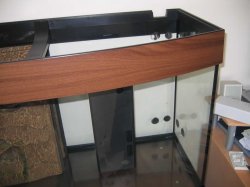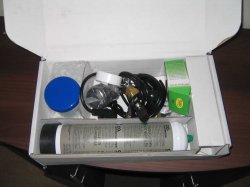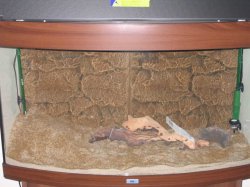This is for ur lights if u want to upgrade, its an article
For those of you starting out in the world of planted aquariums, I've picked my top three mistakes I've seen people make when starting an planted aquarium or converting a fish-only aquarium to include live plants. Consider this a crash-course in starting a planted aquarium. Most of these mistakes lead to the plants dying within a few weeks and, for those of us who don't give up easily, the process is repeated until either our patience or pocket is depleted. Often this is compounded by bad advice given by people at pet stores who often don't know a thing about plants, and even sell plants that aren't true aquatic plants. I'm sure many a potential planted aquarium enthusiast has been lost due to bad advice and these three mistakes. Here they are:
1. But it looks bright! - Often people try to grow plants under the light fixtures that come with an aquarium or come standard in a cheap hood. More than likely, this is a single fluorescent bulb, usually no more than 15 or 20 watts (steer WAY clear of incandescent, they just waste energy, heat your aquarium, and grow algae). The most critical element needed to grow live plants is light. Plants need light to photosynthesize, and without it, they may last a few days or a few weeks on their energy reserves, but eventually they will die. Many people are also mislead by bad advice into believing that the light that is sold with aquariums is adequate. The standard lighting that comes with an aquarium will typically only grow Java Moss and maybe Java Ferns and very poorly at that. If you like ugly, lanky, unhealthy plants go ahead and try it. No matter how bright it may look, it is not enough light. Plants only use specific colors of light, usually in the red and blue ranges. Humans perceive green as brightness. Therefore, what appears bright to us may not actually be helpful to plants. Always choose full spectrum lighting or specific plant growing bulbs, and at least 1.5-2 watts per gallon (WPG) is needed to grow the most basic of aquatic plants in an aquarium. Although this is not set in stone and the watts per gallon rule gets distorted with really small (under 10 gallons) or really big (over 75 gallons) aquariums, it is a good rule of thumb. The following breaks down what ranges qualify as different levels of light:
0-1.5 WPG - Extremely low, pretty much nothing will grow
1.5-2 WPG - Low, basic hardy aquatic plants will grow slowly
2-3 WPG - Medium, most aquatic plants will grow fine
3+ WPG - High, almost any aquatic plant can be grown
What must also be taken into account is the related effect of light levels on a plant. This brings me to mistake number two.
2. But I thought high light = a beautiful aquarium! - Say you splurge and buy an expensive high output light fixture for your aquarium. Throw some plants in and sit back and watch it grow, right? Wrong. Light in an aquarium is like the gas pedal in a car, the more you push it the faster you go, but the quicker things get out of hand, and when it does get out of hand it gets ugly. Having high light is not always best, especially for someone who's new to planted aquariums. A basic understanding of a plant's metabolic process is required (don't worry, I won't go into details). It takes a bunch of raw materials and energy and outputs a finished product (new growth). Raw materials are fertilizers, chemicals needed for growth, and energy is light. If it runs out of any one of these inputs, the whole thing shuts down, and more importantly, it can only go so fast. So when you throw a plant under high light, it immediately kicks the internal mechanisms into high gear. The plants just shut down when they run out of any one of the many chemicals needed to grow. If you don't fertilize your tank, you will quickly find that all high light does by itself is grow algae, and lots of it. Fast. Real fast. For this reason, if you're just starting out, my advice is to get a medium or low light setup. You don't have to fertilize as much (if at all with a low light setup) and things won't be moving at such a fast pace (and thus get out of control so quickly). It's very hard to recover from a serious algae bloom because once it's taken hold, some types are impossible to remove. I've heard horror stories of people being forced to totally break down their tank because of algae. You've got to stay on top of it from the start.







 , my CO2 kit turned up! This one comes with a ceramic disc/bubble counter combo and most importantly for me - a solenoid for switching off at night! Put it together and lost some CO2, the thing did not want to seal correctly so after removing the bottle several times, all is good!!
, my CO2 kit turned up! This one comes with a ceramic disc/bubble counter combo and most importantly for me - a solenoid for switching off at night! Put it together and lost some CO2, the thing did not want to seal correctly so after removing the bottle several times, all is good!!





